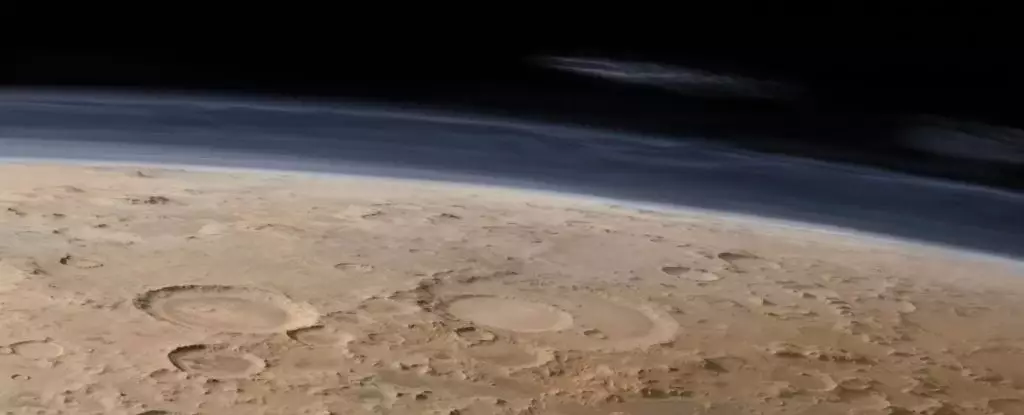Mars has long captivated humanity’s imagination. From its rust-colored terrain to its enigmatic canyons and extinct volcanoes, it serves as both a scientific elixir and an object of fascination for numerous generations. Yet, behind its majestic landscapes lies a troubling story of atmospheric erosion that has transformed the planet over billions of years. Recently, scientists, led by planetary scientist Shannon Curry from the University of Colorado Boulder, have made a groundbreaking discovery regarding one of the main culprits behind the atmospheric depletion on Mars—atmospheric sputtering. With the help of data collected from the MAVEN spacecraft over nearly a decade, researchers have revealed the dynamics of how Mars lost its atmosphere and water, uncovering a potent driver of planetary change.
Understanding Sputtering: An Intricate Mechanism
At the heart of this discovery is the concept of atmospheric sputtering, a phenomenon that profoundly impacts bodies within the harsh, unshielded realms of space. As solar winds—the continuous stream of charged particles emitted by the Sun—collide with Mars’ unprotected atmosphere, they create a reaction akin to a violent meteor strike. This energetic exchange propels certain atmospheric particles beyond the planet’s gravitational pull, opening the gateway to an ever-vanishing atmosphere.
What’s crucial here is that this isn’t just a minor aspect of planetary science; it is fundamental to understanding Mars’ climatological history and its potential for past habitability. Essentially, by tracing how sputtering affects atmospheric loss, we design a clearer picture of what Mars was like in its formative years and what that may mean for life beyond Earth.
A Sophisticated Approach: Decoding Data from MAVEN
Deciphering the puzzle of atmospheric sputtering is no small feat. It requires a highly specialized observational approach, as understanding both the ions responsible for sputtering and the neutral atoms being ejected is critical. With MAVEN’s arrival in Martian orbit in September 2014, researchers had an unparalleled opportunity to collect comprehensive data. The team meticulously analyzed years’ worth of satellite observations, focusing particularly on the correlation between the solar wind’s electric field and the concentrations of argon in the upper atmosphere.
Their findings illuminated an astounding detail: above 350 kilometers (approximately 217 miles), the density of argon fluctuated significantly, revealed to be in direct response to the solar winds. In contrast, lower altitudes exhibited a consistent argon density, indicating a clear delineation and pointing towards active sputtering as the explanatory mechanism. This groundbreaking observation provides substantial backing to the theory that Mars’ atmospheric history is not merely a tale of slow erosion but rather a complex interplay of energetic solar activity, echoing the chaos of a much younger solar system.
Not Just Numbers: Implications for Understanding Mars
The results gathered by Curry’s team go beyond mere data points; they unveil a narrative steeped in implications for our comprehension of Mars. The study found that atmospheric sputtering on Mars is occurring at rates over quadrupled than previously predicted, hinting at higher-than-expected activity levels today. Furthermore, the evidence derived from a solar storm in January 2016 significantly bolstered the connection between increased sputtering and solar phenomena, suggesting that ancient periods of heightened solar activity may have had a considerable impact on Mars’ climatic evolution.
This knowledge does not simply illuminate the Martian atmosphere; it serves as a window into understanding celestial bodies’ evolution and the historical possibilities for habitability. If Mars, which harbors remnants of water and potential biosignatures, lost its atmosphere so dramatically due to mechanisms like sputtering, what does that imply about other exoplanets in similar conditions?
Looking Ahead: The Future of Martian Exploration
As scientists continue to peel back the layers of Martian history through intensive research, we stand at the precipice of transformative discoveries that could reshape our understanding of life’s evolution across the universe. With vast potential for future missions and explorations, incorporating the technological advancements embodied in instruments like MAVEN will be crucial. Each observation compiles a clearer narrative of a planet that may once have harbored life, opening the door to critical questions about our own planet’s atmosphere and prospects for life beyond our home.
Ultimately, how we interpret this newfound knowledge of atmospheric sputtering on Mars is pivotal—not just for Mars, but for humanity’s cosmic narrative itself. The lessons gleaned from this research may help us understand our own planet’s vulnerabilities and resilience in the face of ongoing environmental changes, showcasing the intricate connections within the tapestry of worlds that we inhabit.

